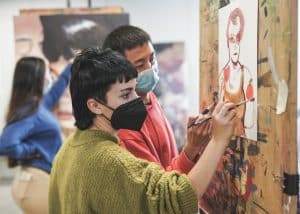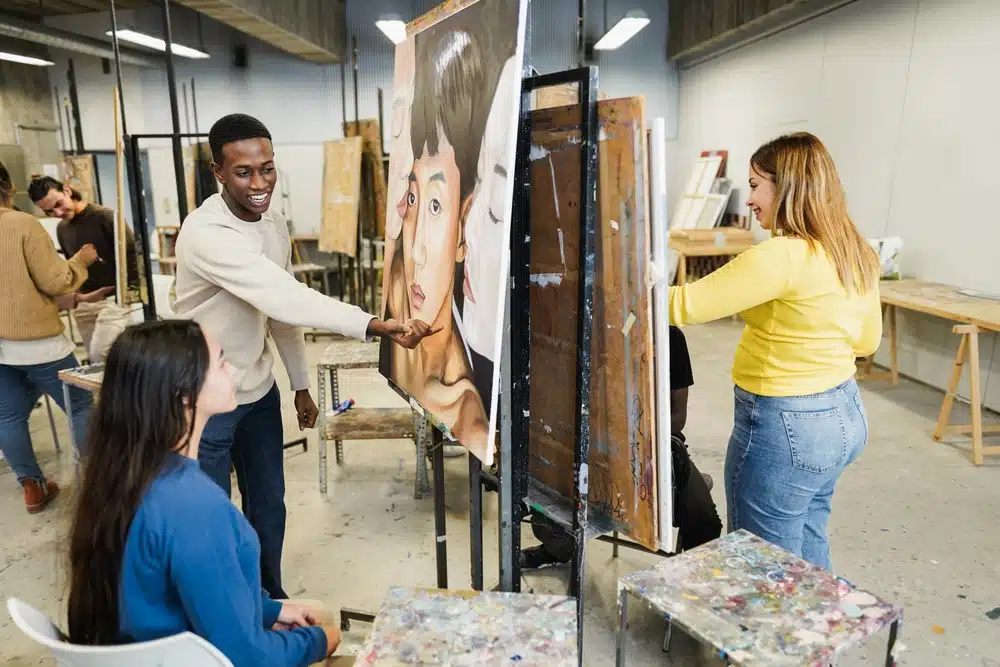If you have a passion for art, there are excellent college options available to you! If you graduated from high school with a strong background in art education and believe you have the talent to pursue a career as an artist or another creative professional, attending an art school is important for acquiring the technical skills necessary for full artistic expression and furthering your level of creativity. So what is the hardest art school to get into in the US?
In this blog, we will explore a list of the hardest art schools to get into and discuss how to get into art school.
10 Hardest and Most Prestigious Art Schools In The US
The prerequisites for attending art school can vary widely, but many of the top art programs are highly competitive. Even with an impressive portfolio and well-crafted application materials, gaining admission to the most prestigious art schools can be challenging. This difficulty arises from the sheer number of talented applicants all vying for limited spots, making it tough to stand out.
Here is a list of all of the hardest art schools to get into in the country:
1. UCLA School of Arts and Architecture
University of California – Los Angeles
- Location: Los Angeles, California
- Acceptance Rate: 5%
The UCLA School of the Arts and Architecture (UCLA Arts) is widely regarded as the best public arts school and the hardest art school to get into in the United States. The school’s prestigious programs are housed within its four leading departments: the Architecture and Urban Design Department, the Art Department, the Design | Media Arts Department, and the World Arts and Cultures/Dance Department.

One of the reasons UCLA Arts is among the hardest art schools to get into is its highly competitive admission process. For instance, the acceptance rate for the Art Department hovers around 4%, which means only the best applicants get in.
Prospective students must submit an impressive portfolio that demonstrates exceptional technical skills and a unique artistic vision. Additionally, the application process includes a detailed personal statement, recommendations, and often interviews or auditions, depending on the program.
UCLA Arts’ exclusivity is also due to its esteemed faculty, which includes renowned artists, architects, designers, and scholars. Notable members include Barbara Kruger, a distinguished conceptual artist, and Thom Mayne, a Pritzker Prize-winning architect.
Famous Alumni
- Tameka Norris – visual and performing artist
- Craig Kauffman – visual artist
- Alexandra Nechita – painter
2. School of the Art Institute of Chicago
- Location: Chicago, Illinois
- Acceptance Rate: 30%
The School of the Art Institute of Chicago (SAIC) is one of the nation’s most prestigious independent art and design schools. Founded in 1866, it is known for its rigorous programs and significant contributions to the art world.
SAIC offers an interdisciplinary curriculum for graduate, post-baccalaureate, and undergraduate students that allows flexibility and continuity for artistic and scholarly development. This blend of academic rigor and creative freedom cements SAIC’s status as a top art and design institution.
SAIC’s highly selective admission process makes it one of the hardest art schools to get into, with an undergraduate acceptance rate of about 30%. Applicants must submit a comprehensive portfolio, a detailed personal statement, letters of recommendation, and sometimes an interview. This process ensures that only the most talented and dedicated students are admitted.
Notable faculty members include Nick Cave, known for his Soundsuits, and Michelle Grabner, an influential artist and curator. The school’s extensive facilities include the Art Institute of Chicago, one of the oldest and largest art museums in the U.S.
Famous Alumni
- Georgia O’Keeffe – modernist painter
- Jeff Koons – contemporary artist
- Cynthia Rowley – fashion designer
3. Rhode Island School of Design
- Location: Providence, Rhode Island
- Acceptance rate: 20%
The Rhode Island School of Design (RISD), founded in 1877, is one of the most prestigious independent art and design schools in the U.S. RISD offers undergraduate and graduate degrees in 19 departments that cover fine arts, design, and architecture.

RISD’s highly selective admission process makes it one of the hardest art schools to get into, with an acceptance rate of around 20%. Applicants must submit a strong portfolio, a personal statement, and letters of recommendation and complete a “Drawing Assignment” to showcase their creativity and skills. This rigorous process ensures that only the most talented and dedicated students are admitted.
Famous Alumni
- James Franco – actor and filmmaker
- Seth MacFarlane – creator of ‘Family Guy’
- Sebastian Errazuriz – contemporary artist and designer
- David Byrne – musician
4. California Institute of the Arts
- Location: Valencia, California
- Acceptance rate: 24%
The California Institute of the Arts (CalArts), established in 1961 by Walt Disney and other industry visionaries, is one of the top art schools in the world. Located in Valencia, California, CalArts offers an innovative approach to arts education across visual, performing, media, and literary arts.
CalArts has a highly selective admission process with an acceptance rate around 24%. Applicants must submit a detailed application, including a portfolio or audition (depending on the program), a personal statement, letters of recommendation, and often an interview. The portfolio or audition must showcase technical skill, creativity, originality, and a strong personal voice.
CalArts features advanced facilities, such as cutting-edge recording studios and performance spaces in the Herb Alpert School of Music, and state-of-the-art animation and post-production labs in the School of Film/Video.
Famous Alumni
- Tim Burton – filmmaker and writer
- John Lasseter – Former Chief Creative Officer of Pixar and Walt Disney Animation Studios
- Brenda Chapman: Co-director of “Brave” and the first woman to direct a major animated feature film, “The Prince of Egypt.”
- Alison Brie – actress
5. Yale University School of Art
Yale University
- Location: New Haven, Connecticut
- Acceptance Rate: 6%
The Yale University School of Art, established in 1869, is one of the most prestigious art schools in the U.S. and is globally recognized for its high standards, influential faculty, and notable alumni network. Located in New Haven, Connecticut, it offers exceptional education in the visual arts as part of Yale University. It is considered to be the hardest art school to get into amongst all Ivy League schools.

Yale School of Art has a highly selective admission process with an acceptance rate of around 6%, making it one of the most competitive art schools in the world. Applicants must submit a portfolio, personal statement, letters of recommendation, and transcripts. The portfolio is critical; it should showcase technical skill, creativity, originality, and unique artistic vision.
The Yale School of Art offers a Master of Fine Arts (MFA) degree in (1) Graphic Design, (2) Painting/Printmaking, (3) Photography, (4) Sculpture. The school provides expansive studios, specialized workshops, and advanced technology for both digital and traditional art-making processes.
Students can exhibit their work in the Green Hall Gallery and the 32 Edgewood Gallery. Additionally, they have access to Yale’s extensive library system, including the Haas Arts Library, which houses a vast collection of art books, periodicals, and special collections.
Famous Alumni
- Richard Serra – sculptor
- Maya Lin – architect and visual artist
- Sheila Hicks – textile artist
- Chuck Close – painter and photographer
6. Savannah College of Art and Design
- Location: Savannah, Atlanta
- Acceptance rate: 70%
The Savannah College of Art and Design (SCAD), founded in 1978, is a highly esteemed private art and design school with campuses in Savannah, Atlanta, and Lacoste (France), and an extensive online program (SCAD eLearning). SCAD is known for its innovative programs and comprehensive arts education and is known to be one of the hardest art schools to get into.
SCAD has a selective admission process with an acceptance rate of about 70%. Admission can still be competitive, especially for top programs. Applicants must submit a portfolio, a statement of purpose, transcripts, and letters of recommendation. Additionally, SCAD evaluates applicants based on their academic achievements and potential for success in their chosen field.
The Savannah campus features Arnold Hall, which features advanced digital media technology, and the SCAD Museum of Art, which features contemporary art exhibitions. SCAD Atlanta also includes the Digital Media Center, which includes state-of-the-art labs for animation, game design, and visual effects.
Famous Alumni
- Octavia Spencer: Academy Award-winning actress
- India Arie: Grammy Award-winning singer and songwriter
- Meredith Pardue: contemporary painter
- Jeremiah Brent: Interior designer and television personality
7. Virginia Commonwealth University School of the Arts
- Location: Richmond, Virginia
- Acceptance rate: 45%
Virginia Commonwealth University School of the Arts (VCUarts) is one of the top public art schools in the U.S. Located in Richmond, Virginia, VCUarts offers a world-class education in the visual and performing arts, promoting creativity, innovation, and critical thinking.
VCUarts has a selective admission process and an acceptance rate of about 45%, reflecting its high standards. The school features advanced studios, workshops, and performance spaces, like the Depot and the Institute for Contemporary Art at VCU, where students can create and showcase their work.

The school’s focus on interdisciplinary learning and both conceptual and practical skills prepares students to lead in the creative industries. VCUarts graduates are known for their critical and creative thinking and make significant contributions to art, design, and culture worldwide.
Famous Alumni
- David Baldacci: best-selling author
- Stephen F. Hayes: journalist and editor
- Myra Mimlitsch-Gray: metalsmith and artist
- Richmond Barthé: sculptor
8. NYU Tisch School of the Arts
New York University
- Location: New York, New York
- Acceptance rate: 19%
The NYU Tisch School of the Arts, established in 1965, is one of the premier arts schools known globally. Located in New York City, Tisch offers programs in various performing and media arts disciplines. Its reputation and prime location make it a top choice for aspiring artists and performers worldwide.
Proximity to Broadway, major film studios, art galleries, museums, and diverse performance venues offers students numerous opportunities for internships, networking, and real-world experiences.
Tisch has a highly selective admission process with an acceptance rate of about 19%. Applicants must submit a strong portfolio, audition, or film reel (depending on the program), a personal statement, letters of recommendation, and transcripts.
The school features advanced studios, theaters, and production facilities, including the Maurice Kanbar Institute of Film and Television, the Clive Davis Institute of Recorded Music, and the Tisch Dance Department studios. Programs like the Interactive Telecommunications Program (ITP) focus on emerging media and technologies.
Famous Alumni
- M. Night Shyamalan: director and screenwriter
- Martin Scorsese: film director
- Spike Lee: filmmaker
- Lady Gaga: singer and actress
9. Parsons School of Design
- Location: New York, New York
- Acceptance rate: 35
Parsons School of Design, part of The New School in New York City, is one of the world’s most prestigious and influential art and design schools. Founded in 1896, Parsons is known for its academic programs and innovative approach to design education.
Parsons has a highly selective admission process with an acceptance rate of about 35%. Applicants must submit a strong portfolio showcasing technical proficiency, creativity, and unique artistic vision, ensuring only the most talented students are admitted.

Key facilities include the Making Center, a 35,000-square-foot space with advanced tools for digital fabrication, woodworking, metalworking, and textiles. The Sheila C. Johnson Design Center hosts exhibitions and public programs, creating a vibrant community of creatives.
The curriculum at Parsons is heavily project-based, allowing students to work on real-world problems and collaborate across different fields of study. Through initiatives like the Parsons DESIS Lab (Design for Social Innovation and Sustainability), students and faculty collaborate with external partners to develop projects that have a positive impact on communities.
Famous Alumni
- Marc Jacobs: fashion designer
- Tom Ford: fashion designer and filmmaker
- Ai Weiwei: contemporary artist and activist
- Alexander Wang: fashion designer
10. Carnegie Mellon University School of Art
- Location: Pittsburgh, Pennsylvania
- Acceptance rate: 7%
Carnegie Mellon University School of Art, located in Pittsburgh, Pennsylvania, is known for its rigorous programs, interdisciplinary approach, and focus on innovation and technology. As part of Carnegie Mellon’s College of Fine Arts, it offers a comprehensive education in the visual arts, integrating traditional practices with new media and technology.
With an acceptance rate of around 7%, the School of Art is highly competitive and is considered the hardest art school to get into The curriculum encourages exploration of digital media, robotics, virtual reality, and other technological advancements. Collaboration with CMU’s School of Computer Science, Robotics Institute, and Entertainment Technology Center allows students to work on projects that combine art, technology, and science.
The Miller Institute for Contemporary Art provides a platform for experimental and research-based art, offering students opportunities to exhibit their work and engage with the broader art community.
How to choose the right art school?
Choosing the right art school is an important phase in your education and career. When choosing, consider your interests and the programs offered. Identify your passion, such as fine arts, graphic design, animation, photography, sculpture, or fashion design, and ensure the school excels in those areas.
Review the curriculum to see if it balances theory and practical skills, emphasizing hands-on experience and project-based learning. Some schools offer an interdisciplinary approach, while some offer programs closely tied to technology or other fields of study.

Moreover, research the faculty and the school’s reputation. Look for accomplished faculty who can provide mentorship. A well-regarded institution can offer more opportunities and have a strong reputation in the art and design community. Alumni success can also indicate the quality of education.
Evaluate the school’s industry connections and career services for internship placements, job fairs, and networking events. Ensure the school is accredited and has high academic standards, as these factors impact financial aid eligibility, credit transfer, and your overall development.
How to get accepted into the most prestigious art schools?
We’re sure that at this point you have asked yourself: how to get into art school? Getting accepted into the most prestigious art schools requires careful preparation, a strong portfolio, and strategic planning.
Here are some tips and specific information to help you achieve this goal:
Develop a Strong Portfolio
- Quality Over Quantity: Focus on showcasing your best work. The hardest art school to get into considers your portfolio as one of your strongest qualifications. A strong portfolio typically includes 10-20 pieces that demonstrate your technical skills, creativity, and unique artistic vision.
- Diverse Range: Include a variety of mediums and techniques to show versatility. For example, if you’re applying to programs like the BFA in Fine Arts at Parsons School of Design or the BFA in Painting at Rhode Island School of Design (RISD), your portfolio should highlight drawing, painting, sculpture, and digital work.
- Conceptual Depth: Include pieces that not only demonstrate technical proficiency but also convey a strong conceptual foundation. Schools like Yale School of Art and California Institute of the Arts (CalArts) look for originality and depth in students’ work.
- Sketchbook Work: Some schools, such as RISD, value seeing your thought process and development of ideas, so including pages from your sketchbook can be beneficial.
Tailor Your Application
- Research Each School: Understand the specific requirements and preferences of each school. For example, Pratt Institute’s School of Art requires a portfolio, artist statement, and recommendation letters.
- Personal Statement: Write a compelling personal statement that explains your artistic journey, influences, and why you want to attend that specific school. Tailor your statement to highlight how the program aligns with your goals.
- Recommendations: Obtain strong letters of recommendation from art teachers, mentors, or professionals who can speak to your abilities and potential.
Prepare for Interviews and Auditions
- Interview Preparation: Some schools, like the School of the Art Institute of Chicago (SAIC), may require an interview. Be prepared to discuss your work, inspirations, and why you want to attend the school.
- Audition Requirements: For performance-based programs (e.g., dance or theater at NYU Tisch School of the Arts), prepare thoroughly for auditions by practicing extensively and selecting pieces that showcase your strengths.
Academic Excellence
- Grades and Test Scores: While art schools place a strong emphasis on portfolios, maintaining good grades and achieving strong test scores (where required) can enhance your application when applying for admission to the hardest art school to get into. For example, Carnegie Mellon University’s School of Art considers academic performance as part of the holistic review process.
- Art-Related Coursework: Enroll in advanced art classes or AP Art courses in high school to build a strong academic foundation in the arts.
Extracurricular Activities and Competitions
- Art Clubs and Organizations: Participate in art-related extracurricular activities to demonstrate your passion and commitment. Leadership roles in these organizations can also be beneficial.
- Competitions and Exhibitions: Entering art competitions and exhibiting your work in local galleries or shows can strengthen your portfolio and resume. Winning awards or recognition can make your application stand out.





































